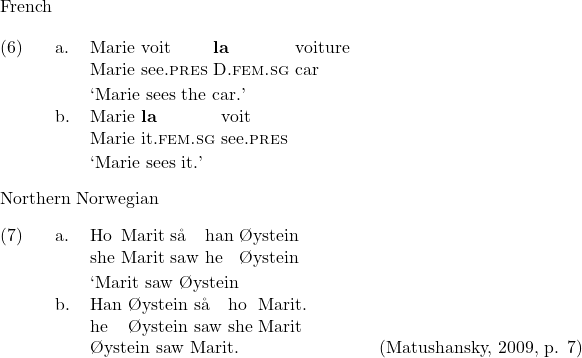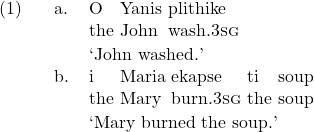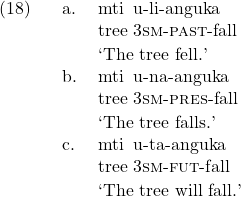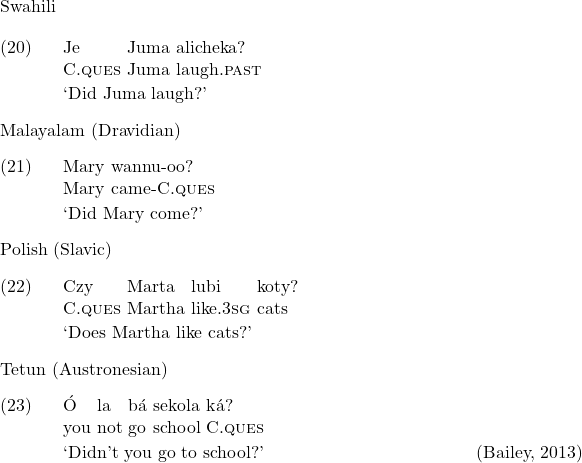5
Learning Objectives
By the end of this chapter, you should,
- recognize the distinction between functional and lexical categories
- be able to use constituency tests to infer the presence of functional structure
- understand the motivation for projecting D, C, and T, even when they’re silent.
- be able to draw the trees for DP, TP, and CP across languages.
In this chapter we’re going to investigate some of the “hidden” parts of syntax. We have until now been looking at what we can see. We can see (and diagnose the category of) nouns, verbs, and adjectives, etc. And we can see constituency. But there are very many categories and constituents that we cannot always see directly. Much of syntactic research involves inferring the presence of structure, things we cannot see.
This is, for many people, an inherent flaw in syntactic theory. Much of syntactic theory involves talking about “invisible” things. However, the reason that we propose such invisible objects is that we can detect the presence of them, even when we can’t see them.
By analogy, we will never directly observe a black hole. It is “invisible” by virtue of the fact that light cannot escape its gravitational pull. However, the evidence suggests that black holes exist, and we can directly observe that evidence. That is, the black hole affects space around it, and we can see those effects. This is the same thing that syntacticians do. (And semanticists too!) Sometimes we infer the presence of an element because we see its effects—even when we do not always see the element itself.
This chapter focuses on functional phrases. The categories we’ve been looking at so far have been lexical categories. Lexical words are, loosely, words with definable meanings. Dog, table, honesty, sing, walk, sadly are all lexical words because the meanings for these words are relatively easy to define. In contrast words like the, a, should, of are functional words of different categories, because it’s not so easy to define these words.
Some people have suggested that the “role” of functional words is not to provide meaning, but rather to link meanings together. For instance, in box of matches the functional words of (a preposition) serves to relate the independent meanings of box and matches. Of by itself doesn’t really carry “weight;” it doesn’t really mean anything. Rather it simply relates the meanings of box and matches. The same thing with the copula is. In Mary is a doctor, the copula is simply equating the meanings of Mary and a doctor. But it doesn’t mean something in the same way that Mary and a doctor mean something.
The lexical/functional distinction also broadly corresponds with open class vs. closed class of words. An open class of words is one which can easily add new words. For instance, nouns are an open class because I can very easily invent a new noun—we do this all the time! A closed class of words is one which does not easily get new words added. It’s much harder to invent a new tense, or a new determiner.
It has also been noticed that the lexical/functional distinction is sometimes apparent in the phonology and morphology. Functional elements are often not even separate words: they’re affixed onto lexical words. This is very true of tense, which is often expressed on the verb (e.g., walked). And often functional elements are “minimal” words, like the determiners a and the. We’ll focus in this chapter on three functional projections D (for Determiner), T (for Tense), and C (for Complementizer).
Functional vs. Lexical words (Andrew Collins; length: 2m 52s)
Determiners
The first functional category we’ll talk about we’ve already seen: Determiners (D). Determiners in English include a and the. The demonstratives this, that, these and those are also category D (in this class). And we’ll also assume that quantifiers like every, some, few, many, etc are determiners, too.
So far, I’ve stipulated to you that constituents like the doctor are DPs, Determiner Phrases, and not, say, NPs, Noun Phrases. It is time to back up this assertion. Logically, there are two choices: we could make DP be a part of NP, or we could make NP be a part of DP. The two choices are shown below.

In this class, we’re going to choose the analysis on the right, in (2). That is, we’re adopting the DP-hypothesis. The DP-hypothesis is the proposal that all noun phrases are encased in a “DP shell.” Below I provide the DP hypothesis in prose, and as a phrase structure rule.
The head of a Determiner-X-Noun-Y sequences is D. (Where X and Y are potential noun modifiers.)
- DP → D (XP) (NP) (YP)
What this hypothesis says is that constituents like the doctor, the happy doctor, the happy silly doctor are not NPs, but rather they’re DPs. It also says that pronouns like I, we, you, us etc, are of category D, and are just DPs, with no associated NP.
Evidence in support of the DP hypothesis comes from a few different sources. The first is distributional evidence. As we’ve observed before, pronouns and constituents like the doctor share a distribution, i.e., they occur in all the same places. We therefore conclude that they are of the same category. (This was the basis for our substitution test.) So what category are pronouns? They are of category D! Why? Well, for one thing, they distribute like determiners. I can say We linguists sang, where we appears in the position reserved for a determiner: in front of a noun.
The structures for we sang and we linguists sang are shown below.

Again, the reasoning is: If she is a DP, and it shares a distribution with the doctor, then the doctor must be a DP as well.
Note that, despite the name “pro-noun,” pronouns do not actually substitute for nouns! In English, we use the word one to substitute for a noun — or really an entire noun phrase, which can include an adjective. But one cannot replace the sequence Det-(Adj-)Noun.

Moreover, in other languages, we clearly see that pronouns share a morphological shape with determiners. This is true of every Romance language (like French) and also many Germanic languages, like Northern Norwegian.

It is a relevant question now to ask whether all NPs are DPs. For instance, in the sentence Birds sing is birds an NP? Or is there a “silent” D present? Based on the previous reasoning, we would conclude that, Yes, there is a silent D. This is because I can substitute the bare noun birds with a pronoun: Birds sing. Yes that’s right, they sing. Thus, again, if pronouns are DPs, and “bare” NPs share a distribution with pronouns, then bare nouns must be DPs as well.
Another reason to think that there really is a Determiner present comes from the basic paradigm of determiners in English. There is a morphological form for singular and plural definite determiners, and one for singular indefinite determiners, but not one for plural indefinite determiners. Given that we would expect there to be an indefinite plural form based on this paradigm, the fact that there isn’t just looks accidental (i.e. given this paradigm, we would expect that the plural indefinite determiner is present, but crucially unpronounced).
| Definite | Indefinite | |
| Singular | the bird | a bird |
| Plural | the birds | ∅ birds |
Moreover, clearly determiners are adding some meaning, so we need to have some way to introduce whatever meaning determiners contribute. How could we do that if there were no determiner with plural indefinites? Indeed, there are many languages which do have plural indefinite determiners, like French, and those DPs mean the same thing as English DPs.[1]

We therefore will assume that “bare” nouns in English and any language have a silent determiner. For a language like Swahili, which does not have a word for the or a, we will assume that they are DPs as well.

Finally, based on the same distributional facts, proper names are also DPs with a silent D. They must be DPs because they are interchangeable with pronouns and constituents like the doctor.

Interestingly, we in fact find that in many languages proper names do appear with Determiners. This is famously true of Greek.

DP-Hypothesis (length: 1m 22s) Credit: Kade Traffas
Trees with DPs (length: 57s)
Key Takeaways about Determiners
- All NPs are inside of a DP (= the DP Hypothesis).
- Sometimes D is silent.
- Proper names are DPs with a silent D..
- Pronouns have category D.
Tense
In this section, we’ll consider the category T, for Tense.[2] In Swahili, we saw evidence that the subject does not form a constituent with the verb. That evidence is repeated below. (8) shows that we can coordinate the verb and object, to the exclusion of the subject.

So where is the subject? This question in fact has a number of different answers depending on which theory you choose. Our idea about the position of the subject will change considerably over the course in this class. This is not because I wish to “trick” you, or to teach you something incorrect. Throughout this book, our understanding of the position of the subject will evolve as we learn more about what is, and is not possible, in Human Language. (We also need to introduce some concepts like “movement,” which we don’t yet have the tools for. We’ll get there in chapter 7.)
We’re going to switch to English for a moment now, and then return to Swahili presently. Look at the following sentences.

These elements don’t seem to belong to any of the categories we’re familiar with. They aren’t verbs because they don’t inflect for tense/aspect/person and they can’t stand on their own in a sentence: *Adam will curry. We must conclude that they are a distinct and unique class of words. Notice also that will is the marker of future tense in English. We therefore hypothesize that these words have the category Tense, abbreviated T.
The following sentences also reveal something important about will, must, and might.

The takeaway from this data is that the verb phrase forms a constituent which is distinct from tense. In sum, the data indicate that,
- VPs form a constituent which is distinct from Tense, and
- Tense changes the category of the phrase. The constituent will cook curry is not a VP, because it doesn’t have the distribution of a VP. For instance, we cannot simply put a plain verb like walk in the same place as will cook curry: *Adam walk.
We conclude therefore that TP is a distinct phrase from VP, and that VP is inside of TP. Thus, the Tense Phrase (TP) rule for English looks like the following.
Tense Phrase in English
- TP → DP T VP
Our TP rule says that the subject is in TP. This is something of a simplification for now, but it’s a move that allows us to get rid of a problematic category: S. You may have noted that S is the sole category that appears to violate the Headedness Principle, since it doesn’t have a head that defines the phrase.
With the addition of the TP rule, we’ve fixed this issue. Now all of our phrases obey Headedness!

So what about the sentences in (12), in which will, must, might are absent? Do these sentences lack a Tense Phrase?

Of course these sentences have tense! They’re past tense. Here, the categories of T and V are expressed as a single word: cooked is a word that is made up of two parts: the verb /cook/ and the past tense marker /-ed/. We will assume for the time being that there is some “morphological magic” that puts words together. (We will return to this issue in chapter 7.)

What else is Tense? In English, the auxiliary words be and have can also instantiate the category Tense (for now), as in the following sentences.

Keep in mind that our terminology is somewhat arbitrary. When we put words into categories, we’re really just saying, “Here’s a group of things that have the same properties.” A noun (phrase) acts like a “noun.” A verb (phrase) acts like a “verb.” It’s a separate question whether the words will, might, can, is, and has form a semantically coherent group (and whether the semantics is that of tense).
Ways to pronounce Tense in English (so far)
Besides tense features, the following are some ways to pronounce T.
![]()
The verb be also patterns as a tense element (when it is inflected).
![]()
And lastly, the word have is sometimes a tense element—whenever it is used as an auxiliary with some other verb.
![]()
The difference here is really the distinction between functional and lexical elements. In (17a), has is functional, while in (17b) it’s lexical, denoting the meaning “possesses.”
Returning to our Swahili examples, we notice that, just like English past tense, Swahili expresses tense as part of the verb. Tense is a verbal prefix. Every finite verb in Swahili consists minimally a subject agreement prefix, followed by a tense marker, followed by a verb. (There are other things that can go in there as well; we’ll cover them later.)

How are words formed? This question gets to heart of a broad and fascinating subfield in linguistics called morphology or morphological theory. Many researchers adopt the idea that word-formation is inextricably tied up with syntactic structure. Words are formed in the syntax, through syntactic processes. Under this theory, words are really a product of the syntax; they are the result of building structure.
On the other hand, many researchers think that words are formed in the lexicon, before syntactic computation. Words are first created, and then inserted into a structure already forms.
The debate is one of the most heated in linguistics, and the two camps are quite distinct, and have argued vehemently against the other. If you’re interested, consider taking Morphology LING 527, which explores these issues in-depth.
Key Takeaways about Tense
- Tense is a projection above the verb phrase.
- Tense can either be a word (might, will, can, …) or just a feature ([past])
- The subject is inside of TP.
Complementizers
The complementizer phrase (CP) is the phrase that “houses sentences.” The function of C, broadly, is to specify whether the sentence is declarative (a statement), interrogative (a question), imperative (a demand), or subjunctive (a non-actual event). (Altogether, these are different Moods.)
C’s function is also to relate an embedded proposition to the main clause. So the clearest place to find complementizer phrases is in front of embedded clauses, as shown in the following Swahili examples.
![Rendered by QuickLaTeX.com \setcounter{ExNo}{18} \ex. \ag. Juma alisema [\textsubscript{CP} kwamba kuna joto ]\\ Juma say.\textsc{past} {} C there.is heat\\ \trans `Juma said that it's hot.' \bg. Jemal anafikiri [\textsubscript{CP} kwamba kuna upepo ]\\ Jemal think.\textsc{pres} {} C there.is wind\\ \trans `Jemal thinks that it's windy.' \cg. Mariamu anaamini [\textsubscript{CP} $\emptyset$ kuna jua ]\\ Mariam believe.\textsc{pres} {} C there.is sun\\ \trans `Mariam believes that it's sunny.'](https://pressbooks.pub/app/uploads/quicklatex/quicklatex.com-608582807e178c41c593434beb19c249_l3.png)
Notice that sometimes we don’t pronounce the complementizer, like in (19c)—but that doesn’t mean it’s not there. Recall that we can have silent determiner, and silent tense elements, so it isn’t really a concession to posit a silent complementizer.
As stated earlier, the function of a complementizer is to specify the “kind” of sentence that is being uttered. Thus, many languages have complementizers whose function is to signify that the sentence is a question. In Swahili, je at the beginning of a sentence signifies that it’s a Yes/No question (20). In Malayalam, the question particle is attached to the verb.

Thus, unembedded clauses can have complementizers as well.[3]
So where do we need a complementizer? In fact, there is a strong consensus that every TP has a CP on top it. (There’s exactly one exception to this generalization, discussed in chapter 11.) Thus, a simple sentence like Mary ate churros or the Swahili sentence below both have a silent C over TP.

This should probably sound surprising to you, since the following sentences are absolutely not possible in English nor Swahili. That is, we can never pronounce the silent C at the top of the sentence.
![Rendered by QuickLaTeX.com \setcounter{ExNo}{26} \ex. \a. *That the hiker bought a pencil. \b. *Whether the river flooded. \c. *If the hideout is in a cave. \ex. \ag. *Kwamba kuna joto\\ C there.is heat\\ \trans [Intended: `*That there is heat.']](https://pressbooks.pub/app/uploads/quicklatex/quicklatex.com-97bca8218fdf36c9ec7be360ad046c07_l3.png)
Still there is very good evidence that that all TPs have CPs on top of them. Consider this (somewhat complex) argument from English.
- A complementizer must be present when forming a question. The presence of Cques is why we have subject-auxiliary inversion in English. The question-complementizer forces the auxiliary to displace to a different position (for reasons we’ll discuss in chapter 7).
- [ Cques [ John will see Mary ] ] → [ Cques+will [ John will see Mary ] ]
- Recall that we cannot coordinate different types of phrases. So I cannot coordinate an NP and PP: *the dog and on the porch. I cannot coordinate a VP and an AdvP *sing a song and loudly.
- Now consider the following sentence. What is being coordinated using but?
- The Lakers made it to the finals, but will Lebron be healthy enough to play?
The answer is that what’s being coordinated is a CP. But that’s only possible if the sentence [ The Lakers made it to the finals ] is a CP.
The way we think of C is that it “types” a clause. It distinguishes between declarative statements (assertions of fact), interrogative statements (questions), demands (imperatives), among others. That is, depending on which C you choose, you’ll get either an assertion, or a question, or an imperative, or something else. Thus, every clause needs something to tell it what kind of a clause it is.
There are non-finite complementizers as well. In English, the non-finite complementizer is for. It heads clauses with infinitives.
![Rendered by QuickLaTeX.com \setcounter{ExNo}{28} \ex. \a. The shark waited [\textsubscript{CP} for the fish to sleep. ] \b. Carol prayed [\textsubscript{CP} for the Lakers to beat the Celtics ] \c. The doctor hoped [\textsubscript{CP} for the swelling to reduce. ]](https://pressbooks.pub/app/uploads/quicklatex/quicklatex.com-d67b1e9e1c8e94f7ebb659c5149bc02c_l3.png)
In Romance languages, the non-finite complementizer is de/di.

Trees with silent functional categories (length: 1m 21s)
Students are often confused by sentences like the following.
![]()
Students mistakenly think that the complementizers at the start of the sentences (that and for) are the highest complementizers in the sentence. This is incorrect. The trick here is that the these CPs are subjects. So these sentences have the following structures.

Trees with clausal (CP) subjects (length: 2m)
Key Takeaways about Complementizers
- Every TP is in a CP (because C determines the “type” of sentence it is).
- C is often silent, but in many languages it can also be pronounced as a separate word, or as part of the verb
Where we’re going
We’ve introduced functional categories. In doing so, we’ve taken a first look at how we can use syntactic tests to infer the presence of structure. Sometimes we don’t pronounce everything in the tree—but that doesn’t mean it’s not there. We’ve seen evidence for null D, null T and null C. There is real empirical motivation for postulating null elements in syntax.
Inferring the presence of hidden things is the bread-and-butter of syntax. There is no human language on earth which uniformly transparently tells us “this is a noun phrase,” or “now I’m pronouncing the verb phrase,” etc. Instead, we as syntacticians must deduce the presence of such constituents. If we’re doing it correctly, then we’re using empirical data to formulate a hypothesis. Hopefully that hypothesis is testable.
Before moving on, I want to emphasize one other thing about the functional heads we’ve looked at. There is a certain parallelism between D, T, and C. In all three cases, the functional head combines directly with some constituent, and in fact, the functional element is in a sense dependent on that constituent. Tense “needs” a verb phrase because the meaning contribution of tense is to situate the event of the verb relative to a time. Determiners “need” an NP because they “determine” the NP. And C needs a TP because it situates a type of clause. D, T, C are meaningless without NP, VP, and TP, respectively.

This parallelism is not accidental. As we’ll talk about in the next chapter, there are certain regularities across categories which allow us to make broad generalizations about language. Indeed, the similarities across structures will be one motivation for adopting the X-bar schema introduced in the chapter.
Advanced
DP: Gender and Number
There are potentially dozens, perhaps even hundreds, of functional categories. For many syntacticians every piece of inflectional morphology corresponds to a distinct functional head. For instance, consider languages which have a productive noun class system. These are languages in which every noun falls into a particular class, as indicated by the morphology that appears on the noun and possibly by how the noun agrees with other elements in the sentence. All Romance languages have such a system, typically called “gender.” In Spanish, it is almost always the case that nouns ending in -o are in the “masculine” class, and nouns ending in -a are in the “feminine” class.[4]
Regardless of the gender of noun in Spanish, plurals are almost always formed by adding an -s at the end of the noun. So each noun can potentially have two pieces of inflectional morphology, which correspond to two distinct heads in the syntax, schematized as below.

Note that the order that morphemes appear in the word tells us the order that they appear in the tree: closer to the root means lower in the tree. Thus, the gender information, which always attaches directly to the root of the word (in this case, puert- ‘door’) is under the head that expresses plurality.
Functional Hierarchies and Cartography
The sequence of functional heads in Spanish D > Num > Gen > N is called a functional hierarchy. This term refers to the hierarchical ordering of functional elements in a tree. In Spanish (and in fact, as a crosslinguistic rule), information concerning noun class (i.e., gender) always appears lower than information concerning number (i.e., singular or plural).[5]
The idea of a functional sequence of heads is most famously found in the verbal domain. Guglielmo Cinque, studying the acceptable sequences of adverbial elements, has proposed the following universal sequence of functional projections.[6]
MoodPspeech act > MoodPevaluative > MoodPevidential > ModPepistemic > TPPast > TPfuture > MoodPirrealis > TPanterior > ModPalethic > AspPhabitual > AspPrepetitive(I) > AspPfrequentative(I) > ModPvolition > AspPcelerative(I) > AspPterminative > AspPcontinuative > AspPperfect > AspPretrospective > AspPproximative > AspPdurative >AspPprogressive > AspPprospective > AspPinceptive(I) > ModPobligation > ModPability > AspPfrustrative/success > ModPpermission > AspPconative > AspPcompletive(I) > VoiceP> AspPrepetitive(II) > AspPfrequentative(II) > AspPcelerative(II) > AspPinceptive(II) > AspPcompletive(II) > V
In this approach, each kind of adverbs appears in a dedicated position in the structure. This approach is called cartographic, because it “maps” the functional projections. For instance, evidential adverbs like clearly (Sasha clearly lied) always appear above epistemic adverbs like probably (Sasha probably lied). Thus, Sasha clearly probably lied but not *Sasha probably clearly lied.
Cartographic approaches to functional hierarchies clearly “explode” the trees that build. For theorists, the functional hierarchy describes every tree. That is, the sequence of adverbial heads above is always projected in every tree, whether there is an adverb there are not. For other theorists, the projections are on a “use-them-when-you-need-them” basis. You only need a phrase for AspPfrequentative(I) if you actually have an adverb like often in your tree.
Obviously in this class we won’t assume the extreme version of the cartographic approach: you do not need to draw every single phrase when you’re making your trees. But we are implicitly assumed a more moderate approach. For instance, it will become clear later that, when drawing trees DPs in languages like Spanish, we’ll want to always have heads for Gen and Num, even when those heads aren’t necessarily pronounced. So the singular la puerta will have the following structure, where we assume a null exponent for Num.

The reason for this is that we still interpret singular number, even if we don’t pronounce it.
- A note about glossing conventions: we use parentheses in combination with an asterisk in two different ways. Written with the asterisk on the outside, *(XP) indicates that the sentence is ungrammatical without XP. Written with the asterisk on the inside, (*XP) indicates that the sentence is ungrammatical with XP. ↵
- In many theories, this category is simplified as "I" for "Inflection." T and I are interchangeable for all intents and purposes. The reason that some prefer the term I is that this category is associated with subject agreement cross-linguistically, which is inflectional material. ↵
- And in fact, many languages allow complementizers to be used on unembedded sentences in non-question contexts. These often have "exclamative" or [pb_glossary id="125"]evidential[/pb_glossary] meanings. ↵
- It is important to keep in mind though that there is nothing inherently "gendered" about this kind of noun class system; chairs, windows, trees, etc, are not inherently masculine feminine or otherwise. ↵
- In linguistics, we use the term "number" to refer to (non-)plurality, not to the numbers 1, 2, 3, 4, ... . ↵
- Cinque, Guglielmo. 2006. Restructuring and Functional Heads: The Cartography of Syntactic Structures. Oxford: Oxford University Press. ↵
Functional words typically provide relationships between lexical words, or specify properties of lexical words. Their meanings are often difficult to define, and are dependent on the presence of a lexical word.
Lexical words have "content," and are typically easily definable, referring to things, events, actions, or abstract properties. They contrast with functional words.
Quantifiers are sub-category of Determiners and include things like every, some, each, all, few, most, etc. Quantifiers are used to express a proportion of the associated NP.
A family of constituency tests that tests constituency by replacing a string of words with another form, typically a pro-form.
Morphology is the study of morphemes. Morphemes are defined as the smallest unit of meaning.
A prefix is a morpheme that attaches at the beginning of a word.
When an auxiliary verb appears in front of the subject. Formally, this is analyzed as T-to-C movement.
